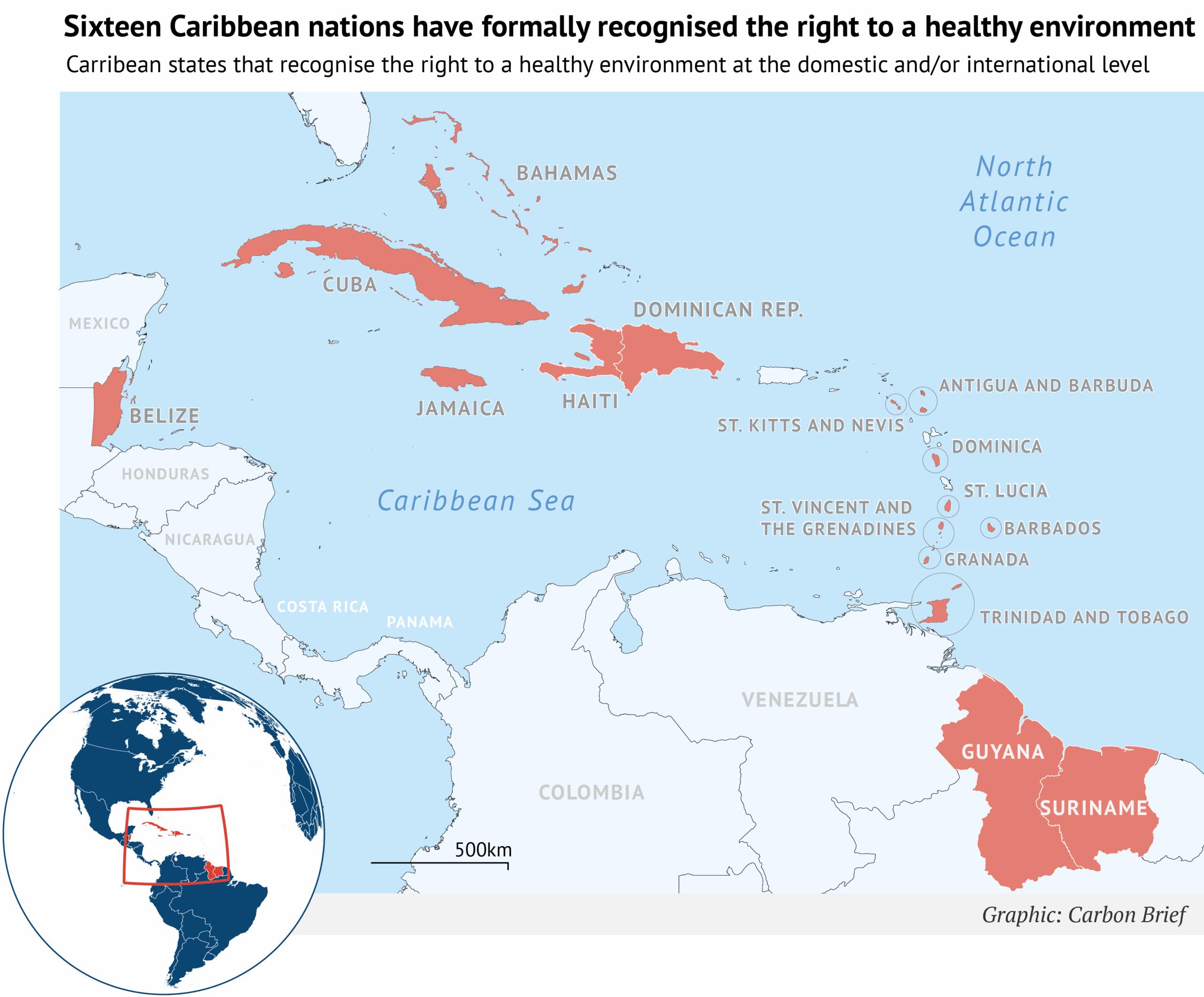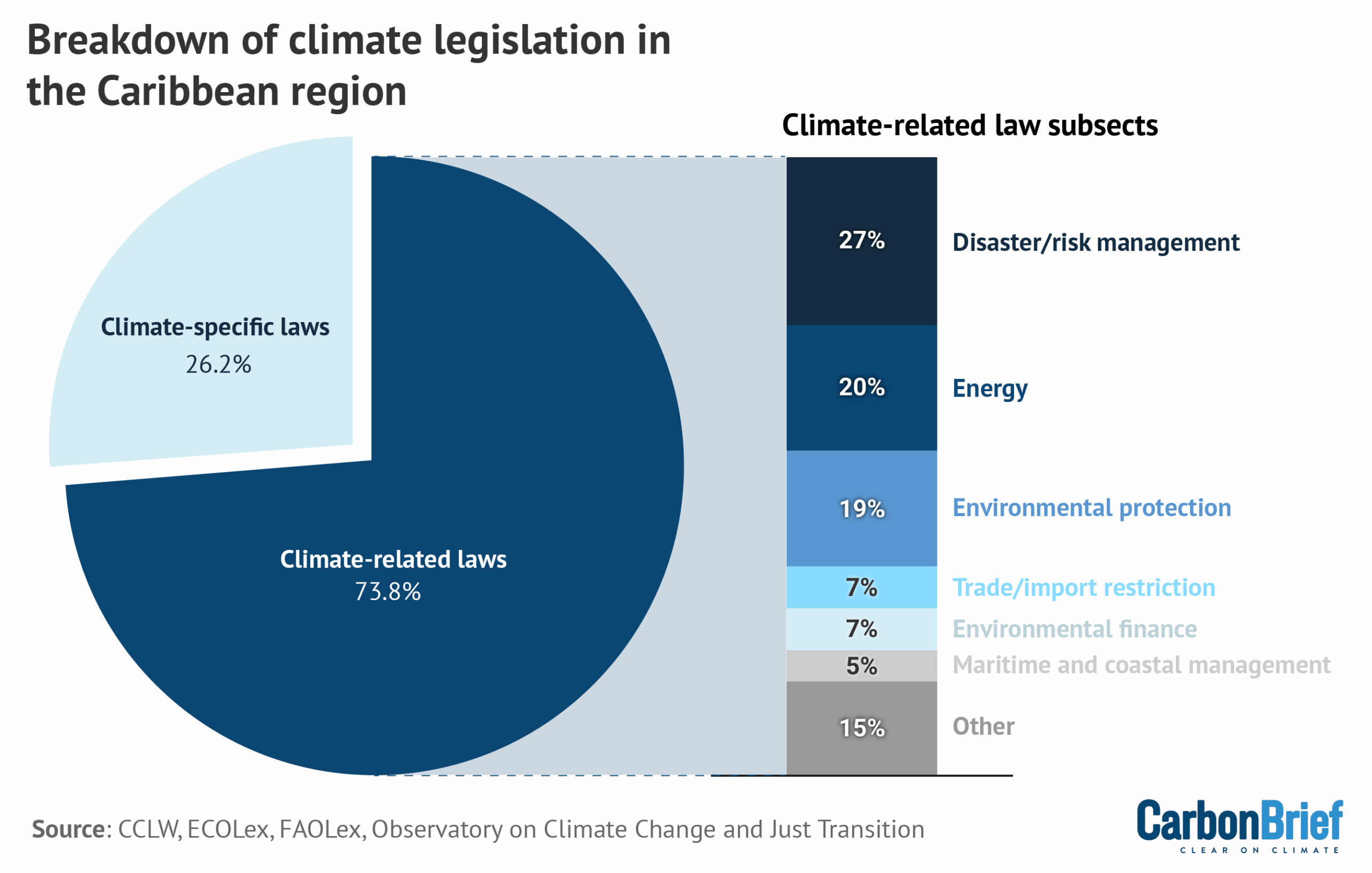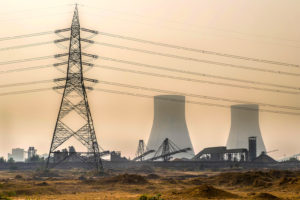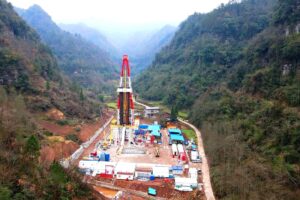Welcome to Carbon Brief’s DeBriefed.
An essential guide to the week’s key developments relating to climate change.
This is an online version of Carbon Brief’s weekly DeBriefed email newsletter. Subscribe for free here.
This week
Unprecedented heat
‘RED ALERT’: The UN’s World Meteorological Organization (WMO) issued a “red alert” on climate change, after 2023 saw record heat, ice-melt and greenhouse gas emissions, the Associated Press reported. The WMO’s report confirmed that 2023 was the hottest year on record, with the average global temperature reaching 1.45C, noted the Guardian. The world is getting ever closer to temporarily breaching 1.5C, the ambition set under the Paris Agreement, the Independent said.
IMPACTS REVEALED: According to the WMO, extreme weather events are having an “alarming” impact on food insecurity, the Financial Times reported. The FT said there were 333 million people in 2023 who were “acutely food insecure”, compared to 149 million people before the Covid-19 pandemic. Elsewhere, Al Jazeera reported that “over 90% of ocean waters experienced heatwave conditions at least once” in 2023.
SCIENTISTS STUNNED: Reacting to the report, Prof Jonathan Bamber, a glaciologist at the University of Bristol, told the i newspaper: “The pace of climate breakdown that we’re witnessing is faster than I think the vast majority of climate scientists were anticipating five or 10 years ago. Things are changing so rapidly that myself and quite a few of my colleagues do have concerns that some of our estimates could be on the conservative side.” It comes as leading climate scientist Dr Gavin Schmidt published a piece in Nature saying that researchers are finding 2023’s extremes “hard to explain” and that Earth could be entering “uncharted territory”.
Big Oil backtracks
TEXAS HOLD ‘EM: As Earth continues to face record-breaking extremes, executives from the world’s leading oil-and-gas companies gathered this week to “pour scorn” on efforts to move away from fossil fuels, reported the Guardian. According to the newspaper, Amin Nasser, the chief executive of state firm Saudi Aramco, told the industry’s annual Cera Week summit in Texas: “We should abandon the fantasy of phasing out oil and gas and instead invest in them adequately.”
BUSINESS AS USUAL: Also reporting on the summit, Reuters noted that many oil-and-gas CEOs shared Nasser’s views, adding: “Shell’s Wael Sawan point[ed] to government bureaucracy in Europe as slowing needed development. Petrobras CEO Jean Paul Prates said caution should overrule haste. Exxon Mobil CEO Darren Woods also said regulations governing clean fuels have still not been resolved.” It came as the Guardian covered a new report from Global Witness suggesting that emissions connected to top oil and gas firms could cause 11.5 million additional heat deaths by 2100.
Around the world
- CLIMATE MINISTERIAL: At a climate ministerial in Copenhagen, a “troika” made up of the United Arab Emirates, Azerbaijan and Brazil – the hosts of COP28, COP29 and COP30, respectively – urged countries to update their international emissions pledges by 2025, the Hindustan Times reported.
- SCHOOL CLOSURES: South Sudan has closed all its schools for an expected two weeks as temperatures are forecast to reach 45C, BBC News reported. It comes as Carbon Brief covered a new attribution analysis finding climate change made recent heat in west Africa 10 times more likely.
- US TRANSPORT: The Biden administration announced new rules to tackle pollution from the nation’s cars and light trucks, “imposing tailpipe emission limits so stringent they will compel automakers to rapidly boost sales of battery-electric and plug-in hybrid models”, Bloomberg reported.
- UK COURTS: The UK Court of Appeal has ruled that climate activists prosecuted in England and Wales for criminal damage can no longer use the “consent defence” – that they believe the property owner would have given their consent to the action if they understood the reason for the protest – the Financial Times reported.
- GREEN STEEL: A new report found that China is “falling short” in decarbonising its steel sector, due to “slowing demand, low recycling rates and lingering overcapacity concerns” impeding the transition to lower-emission production, said Reuters.
- BRAZIL HEATWAVE: Following a record “heat index” (which factors in the impact of humidity) of up to 62C in the Brazilian capital Rio de Janeiro last weekend, O Globo reported that heatwaves may become more frequent in the country.
13 million
The number of residents in India’s southern tech capital of Bengaluru who are running out of groundwater following an “unusually hot” February and March, the Associated Press reported.
Latest climate research
- Over the past 60 years, livestock grazing has reduced soil carbon stocks by 46bn tonnes of carbon at a depth of one metre, a study in Nature Climate Change found.
- Research in Nature Cities found that only 43% of 793 cities studied have implemented green recovery plans in response to the Covid-19 pandemic.
- A study in Climatic Change gathered the opinions of 20 policymakers and practitioners from different countries about the readability of figures drafted for the latest Intergovernmental Panel on Climate Change (IPCC) report on how to tackle climate change. It recommended ways that the figures could be improved, based on the feedback.
(For more, see Carbon Brief’s in-depth daily summaries of the top climate news stories on Monday, Tuesday, Wednesday, Thursday and Friday.)
Captured

New Carbon Brief analysis debunked 18 of the most common and persistent myths about heat pumps. Heat pumps can significantly cut greenhouse gas emissions (see chart above) and are the “central technology in the global transition to secure and sustainable heating”, according to the International Energy Agency. Yet, in major economies such as the UK and Germany, heat pumps are the subject of hostile and misleading reporting across many mainstream media outlets, according to Carbon Brief’s new factcheck.
Spotlight
Rare-earth mining in Myanmar
This week, Carbon Brief interviews an expert about how rare-earth mining in Myanmar has increased since the country’s military coup in 2021, its impacts on local communities and the environment, plus how it can be better monitored and controlled.

Myanmar is rich in natural resources. It is home to a wealth of gemstones, energy sources, such as coal and uranium, as well as vast amounts of rare earths.
Dysprosium and terbium are two rare earths that are heavily mined in Myanmar. They are used in a range of everyday technologies, such as light bulbs, but are increasingly being used for renewable energy, including for electric vehicles and wind turbines.
As countries race to achieve their climate targets, demand for these rare earths is substantially increasing. The Irrawaddy reported that Myanmar exported more than 140,000 tonnes of rare-earth deposits to China between May 2017 and October 2021, valued at more than $1bn.
However, much of Myanmar’s mining industry is illicit and controlled by armed groups. Illegal mining has grown since the country’s military coup in 2021, particularly along the Chinese border in Kachin State.
China, the world’s biggest low-carbon technology producer and the largest processor of rare earths, is now increasingly outsourcing its mining activities into neighbouring Myanmar amid growing national concerns over the highly polluting process.
Below, Carbon Brief speaks to Vicky Bowman (pictured above), director of the not-for-profit Myanmar Centre for Responsible Business, about escalating issues with rare-earth mining in the country. The interview has been edited for clarity and length.
Carbon Brief: Please can you give an overview of rare-earth mining in Myanmar and how it has developed since the military coup in 2021?
Vicky Bowman: Rare-earth mining has been taking place in Kachin state, north-eastern Myanmar, on China’s border for around a decade, mainly by Chinese miners in areas under the control of the pro-military Kachin militias. Chinese companies started to source more from Kachin state because of a clampdown on rare-earth mining in Yunnan due to environmental pollution.
Satellite footage commissioned by Global Witness showed that rare-earth mining has significantly expanded since the coup. It also takes place to a lesser extent in areas controlled by the Kachin Independence Organisation (KIO), which is opposed to the Myanmar military. The KIO planned to expand rare-earth mining to raise funds for their armed struggle, but they faced significant local backlash and dropped the expansion plans in 2023.
CB: What impacts is rare-earth mining having on people, particularly Indigenous peoples, and the environment in Myanmar?
VB: Indigenous peoples in the areas where rare-earth mining is taking place in Kachin state, mostly Kachin ethnic minority, rely on agriculture and forests for their livelihood and culture. These areas are also rich in biodiversity. The leaching process for extracting rare-earth ores requires leaching it from the soil using ammonia and other chemicals. These chemicals enter the environment and poison the streams and fields, killing trees, cattle and local nature and making local people sick.
CB: What needs to happen to better monitor and control the impacts of rare-earth mining in Myanmar?
VB: The vast majority of mining in Myanmar nowadays is unplanned, unregulated and unlicensed. The national Mining Law is not fit for purpose. It fails to align with other laws, such as those concerning investment, environmental protection and land use. There are few, if any, officials in any of the ministries who understand how to regulate mining. Corruption is rife. If and when Myanmar’s political crisis is resolved, the policy and legal framework for mining needs to be completely overhauled into a federal system, which can ensure effective land-use planning and environmental protection, and transparent tax revenues for central and sub-national governments and local communities.
Indeed, creating an effective framework for responsible mining is central to resolving conflicts between local people and the central government, and should be a priority for anyone working on peace.
Watch, read, listen
WHEN HEAT KILLS: A new documentary by Deutsche Welle investigated the effects of extreme heat on human health, particularly for outdoor workers, as the climate warms.
CLIMATE OF FEAR: Atmospheric scientist Prof Adam Sobel unpacked coping with the daunting uncertainties of climate change in an article in Nature.
RIGHTS FOR NATURE?: The latest episode of the Guardian’s Science Weekly podcast explored the contested concept of whether nature should have rights.
Coming up
- 18-29 March: First part of the 29th annual session of the International Seabed Authority, Kingston, Jamaica
- 23 March: UN observed World Meteorological Day
- 24 March: Senegalese presidential election
- 26 March: IEA-Power Africa – Data-driven electrification in Africa webinar, remote
Pick of the jobs
- Science Media Centre, internship | Salary: London Living Wage (£13.15 an hour). Location: London
- Climate Analytics, head of climate science and impacts team | Salary: Unknown. Location: Berlin, Germany
- British Antarctic Survey, glacial sedimentologist | Salary: £39,375-£43,313. Location: Cambridge, UK
- Work On Climate, founders programme manager | Salary: $70,000-90,000. Location: Remote, US
- European Energy Research Alliance, clean energy transition expert | Salary: Unknown. Location: Brussels, Belgium
DeBriefed is edited by Daisy Dunne. Please send any tips or feedback to debriefed@carbonbrief.org
The post DeBriefed 22 March 2024: ‘Red alert’ for Earth; Heat-pump myths factchecked; Myanmar’s rare-earth mining crisis appeared first on Carbon Brief.
Greenhouse Gases
DeBriefed 10 October 2025: Renewables power past coal; Legacy of UK’s Climate Change Act; Fukushima’s solar future
Welcome to Carbon Brief’s DeBriefed.
An essential guide to the week’s key developments relating to climate change.
This week
Renewables overtake coal
‘HISTORIC FIRST’: Renewables have overtaken coal to become the world’s leading source of electricity for the first six months of this year in a “historic first”, BBC News said. The analysis, from the thinktank Ember, found the world generated “almost a third” more solar power in the first half of the year, compared with the same period in 2024, while wind power grew by “just over 7%,” reported the Guardian.
HEAVY LIFTING: According to the report, China and India were “largely responsible for the surge in renewables”, while the US and Europe “relied more heavily on fossil fuels,” the Guardian wrote. China built more renewables than every other country combined in the first half of this year, the newspaper added.
CONTINENTAL SHIFTS: A second report from the International Energy Agency (IEA) predicted a “surge” in global wind and solar capacity by 2030, but shaved 5% off its previous forecast, the Financial Times said. The IEA revealed that India is set to become the second-largest growth market for renewables after China, “with capacity expected to increase 2.5 times by 2030”, Down to Earth reported. The IEA also upped its forecast for renewables in the Middle East and north Africa by 23%, “helped by Saudi Arabia rolling out wind turbines and solar panels”, but halved the outlook for the US, the FT noted.
Around the world
- EV BOOM: Sales of electric and hybrid cars made up “more than half” of all new car registrations in the UK last month, a new record, according to data from the Society of Motor Manufacturers, reported BBC News.
- BANKING COLLAPSE: A global banking alliance launched by the UN to get banks to slash the carbon footprint of their loans and investments and help drive the transition to a net-zero economy by 2050 has collapsed after four years, Agence France-Press reported.
- CUTS, CUTS, CUTS: The Trump administration plans to cut nearly $24bn in funding for more than 600 climate projects across the US, according to documents reviewed by the Wall Street Journal.
- PEOPLE POWER: A farmer, a prison guard and a teacher were among those from the Dutch-Caribbean island Bonaire who appeared at the Hague on Tuesday to “accuse the Netherlands of not doing enough to protect them from the effects of climate change”, Politico reported.
400,000
The number of annual service days logged by the US National Guard responding to hurricanes, wildfires and other natural disasters over the past decade, according to a Pentagon report to Congress, Inside Climate News reported.
Latest climate research
- Politicians in the UK “overwhelmingly overestimate the time period humanity has left to bend the temperature curve”, according to a survey of 100 MPs | Nature Communications Earth and Environment
- Fire-driven degradation of the Amazon last year released nearly 800m tonnes of CO2 equivalent, surpassing emissions from deforestation and marking the “worst Amazon forest disturbance in over two decades” | Biogeosciences
- Some 43% of the 200 most damaging wildfires recorded over 1980-2023 occurred in the last decade | Science
(For more, see Carbon Brief’s in-depth daily summaries of the top climate news stories on Monday, Tuesday, Wednesday, Thursday and Friday.)
Captured

The UK’s Climate Change Act, landmark legislation that guides the nation’s response to climate change, is increasingly coming under attack from anti-net-zero right-leaning politicians. In a factcheck published this week, Carbon Brief explained how the UK’s Climate Change Act was among the first comprehensive national climate laws in the world and the first to include legally binding emissions targets. In total, 69 countries have now passed “framework” climate laws similar to the UK’s Climate Change Act, with laws in New Zealand, Canada and Nigeria among those explicitly based on the UK model. This is up from just four when the act was legislated in 2008. Of these, 14 are explicitly titled the “Climate Change Act”.
Spotlight
Fukushima’s solar future
This week, Carbon Brief examines how Fukushima helped to recover from nuclear disaster by building solar farms on contaminated farmland.
On 11 March 2011, an earthquake off the pacific coast of Japan caused 15m-tall waves to crash into the eastern region of Tōhoku, killing 19,500 people and injuring a further 6,000.
In the aftermath, flooding at the Fukushima Daichi nuclear power plant caused cooling systems to fail, leaching radioactive contaminants into the soil and leading to a major nuclear incident.
Some 1,200km2 around the site was restricted and up to 100,000 people were evacuated – in some cases forever.
In the years following, Japan entered a fraught debate about nuclear energy.
In 2010, nuclear power provided 25% of Japan’s electricity, but, in the years following the disaster, its 54 nuclear reactors were taken offline.
Successive governments have fought over reintroducing nuclear power. Today, some 14 reactors are back online, 27 have been permanently closed and another 19 remain suspended. (Japan’s newly-elected prime minister Sanae Takaichi has promised to make nuclear central to her energy strategy.)
Against this backdrop, Fukushima – a prefecture home to 1.8 million people – has emerged as a surprise leader in the renewables race.
In 2014, the Fukushima Renewable Energy Institute (FREA) opened with the twin goals of promoting research and development into renewable energy, while “making a contribution to industrial clusters and reconstruction”.
That same year, the prefecture declared a target of 100% renewable power by 2040.
Contaminated land
“A lot of these communities, I know, were looking for ways to revitalise their economy,” said Dr Jennifer Sklarew, assistant professor of energy and sustainability at George Mason University and author of “Building Resilient Energy Systems: Lessons from Japan”.
Once evacuation orders were lifted, however, residents in many parts of Fukushima were faced with a dilemma, explained Skarlew:
“Since that area was largely agricultural, and the agriculture was facing challenges due to stigma, and also due to the soil being removed [as part of the decontamination efforts], they had to find something else.”
One solution came in the form of rent, paid to farmers by companies, to use their land as solar farms.
Michiyo Miyamoto, energy finance specialist at the Institute for Energy Economics and Financial Analysis, told Carbon Brief:
“The [Fukushima] prefecture mapped suitable sites early and conducted systematic consultations with residents and agricultural groups before projects were proposed. This upfront process reduced land-use conflicts, shortened permitting timelines and gave developers clarity.”
As a result, large-scale solar capacity in Fukushima increased to more than 1,300 megawatts (MW) from 2012 to 2023, according to Miyamoto. Moreover, installed renewable capacity now exceeds local demand, meaning the region can run entirely on clean power when conditions are favourable, Miyamoto said.
Today, aerial pictures of Fukushima reveal how solar panels have proliferated on farmland that was contaminated in the nuclear disaster.

Charging on
Last year, 60% of Fukushima’s electricity was met by renewables, up from 22% in 2011. (The country as a whole still lags behind at 27%.)
And that is set to grow after Japan’s largest onshore windfarm started operations earlier this year in Abukuma, Fukushima, with a capacity of 147MW.
The growth of solar and wind means that Fukushima is already “ahead of schedule” for its 2040 target of 100% renewable power, said Miyamoto:
“The result is a credible pathway from recovery to leadership, with policy, infrastructure and targets working in concert.”
Watch, read, listen
OVERSHOOT: The Strategic Climate Risks Initiative, in partnership with Planet B Productions, has released a four-part podcast series exploring what will happen if global warming exceeds 1.5C.
DRONE WARFARE: On Substack, veteran climate campaigner and author Bill McKibben considered the resilience of solar power amid modern warfare.
CLIMATE AND EMPIRE: For Black history month, the Energy Revolution podcast looked at how “race and the legacies of empire continue to impact the energy transition”.
Coming up
- 12 October: presidential elections, Cameroon
- 13-14 October: Pre-COP, Brasilia, Brazil
- 13-18 October: World Bank Group/IMF annual meetings, Washington DC
- 14-17 October: 2nd extraordinary session of the Marine Environment Protection Committee at the International Maritime Organisation, London
- 15-16 October: Circle of Finance Ministers report
Pick of the jobs
- Buckinghamshire Council, principal climate change officer | Salary: £49,354-£51,759. Location: Aylesbury, Buckinghamshire
- Sustainable NI, sustainable business lead | Salary: £60,000. Location: Belfast, Northern Ireland
- Dialogue Earth, South Asia managing editor | Salary: £1,875 per month. Location: South Asia
DeBriefed is edited by Daisy Dunne. Please send any tips or feedback to debriefed@carbonbrief.org.
This is an online version of Carbon Brief’s weekly DeBriefed email newsletter. Subscribe for free here.
The post DeBriefed 10 October 2025: Renewables power past coal; Legacy of UK’s Climate Change Act; Fukushima’s solar future appeared first on Carbon Brief.
Greenhouse Gases
Guest post: How Caribbean states are shifting climate legislation
The Caribbean region is among the most vulnerable to climate change, despite historically contributing less than half of one percent of global greenhouse gas emissions.
Rising sea levels, extreme heat and more frequent and intense storms – such as the 2024 Hurricane Beryl, which made landfall in Grenada – pose urgent and growing threats to the small island states, coastal nations and overseas territories that comprise the Caribbean region.
With global progress to address climate change still too slow, Caribbean countries are taking matters into their own hands by enacting more robust legislation to help protect against climate risks.
In a new study published in the Carbon and Climate Law Review, we identified 78 climate laws and legally binding decrees across 16 Caribbean states, as well as two constitutional references to climate change and a growing recognition of the right to a healthy environment.
Our analysis suggests that, together, these developments are not only enhancing resilience, but also positioning Caribbean states as influential actors in the global climate arena.
Caribbean climate laws on the rise
Climate governance in the Caribbean has expanded significantly in recent years. In the past decade, countries such as Cuba and the Dominican Republic have embedded climate obligations and programmatic guidelines into their national constitutions.
At the same time, legislative recognition of the human right to a healthy environment is gaining momentum across the region. Six Caribbean nations now affirm the right in their constitutions, while 15 have recognised it through international instruments, such as the UN Council, UN Assembly and the Escazu Agreement, as shown in the figure below.

More recently, there has been a notable rise in targeted, sector-specific climate frameworks that go beyond broader environmental statutes.
Saint Lucia stands out as the only country with a climate framework law, or a comprehensive national law that outlines long-term climate strategies across multiple domains. Meanwhile, several other Caribbean governments have adopted climate-specific laws that focus on individual sectors, such as energy, migration and disaster management.
According to our analysis, more than a quarter of climate-relevant legislation in the region – comprising 21 laws and legally binding decrees – now has an explicit focus on climate change, as illustrated in the chart below.
Our research suggests that this represents an ongoing shift in legislative focus, reflecting changes in how climate legislation is being structured in one of the world’s most climate-vulnerable regions.

Caribbean nations are also advancing legal reforms to structure and institutionalise climate finance and market mechanisms directly into domestic law, aligned with Article 6.2 of the Paris Agreement.
For example, the Bahamas has introduced provisions for carbon credit trading, while Antigua and Barbuda, Barbados and Grenada have established national climate financing mechanisms to support mitigation and adaptation efforts.
Some states, including Belize and Saint Kitts and Nevis, have incorporated regional bodies such as the Caribbean Community Climate Change Centre – the climate arm of the intergovernmental Caribbean community organisation CARICOM – into national frameworks. This indicates an increasing alignment between regional cooperation and domestic law.
In addition to the influx of regulations specifically addressing climate change, Caribbean nations are also legislating broader environmental issues, which, in turn, could provide increased resilience from climate impacts and risks, as shown in the graph above.
Key trends in these types of climate-related laws include the expansion of disaster risk management governance, which addresses national preparedness for climate-induced weather events or related catastrophes. Likewise, energy law is an increasingly prominent focus, with countries including Antigua and Barbuda and Saint Vincent and the Grenadines integrating renewable energy and energy efficiency goals into national climate governance.
More broadly, many Caribbean nations have adopted wide-ranging and comprehensive environmental laws, many of which were developed in alignment with existing climate commitments. In combination, these legal developments reflect a dynamic and evolving climate governance landscape across the region.
Proactive vs reactive approaches
Despite general alignment with these broader regional trends, our research reveals distinct developmental pathways shaping domestic climate regulation.
In the eastern Caribbean, for example, we saw both proactive, long-term planning strategies and reactive, post-disaster reforms.
Saint Lucia’s multifaceted approach to climate resilience evolved steadily over the course of more than a decade. During this time, the country developed numerous adaptation plans, strengthened cross-sectoral coordination and engaged in institutional climate reforms in areas such as energy, tourism, finance and development.
More recently, the passage of Saint Lucia’s Climate Change Act in 2024 marked a milestone in climate governance, by giving legal force to the country’s obligations under the UNFCCC, the Kyoto Protocol and the Paris Agreement – making Saint Lucia one of the few small island states to incorporate global climate commitments into domestic law.
Our research indicates that this strategy has not only positioned the country as a more climate-resilient nation, but also solidified its access to international climate financing.
In contrast, Dominica’s efforts evolved more rapidly in the aftermath of Hurricane Maria in 2017, which destroyed over 200% of the country’s GDP. The storm’s impacts were felt across the country and hit particularly hard for the Kalinago people – the Caribbean’s last Indigenous community – highlighting the role of socioeconomic disparities in shaping climate vulnerability and resilience.
In response, the government passed the Climate Resilience Act, creating the temporary Climate Resilience Execution Agency for Dominica (CREAD).
Beyond establishing an exclusively climate-focused institution, the act aimed to embed resilience into governance by mandating the participation of vulnerable communities – including Indigenous peoples, women, older people and people with disabilities – in shaping and monitoring climate resilience projects.

As noted in a recent statement by the UN special rapporteur on Climate Change, Dr Elisa Morgera, these frameworks underscore the government’s ambition to become the world’s first “climate-resilient nation.”
Although challenges persist, Dominica’s efforts demonstrate how post-disaster urgency can drive institutional change, including the integration of rights and resilience into climate governance.
Uneven progress and structural gaps
Despite significant progress, our research shows that several key opportunities for climate governance across the Caribbean continue to exist, which could enable improvements in both resilience and long-term ambition.
The region’s legal landscape remains somewhat heterogeneous. While Saint Lucia has enacted a comprehensive climate framework law, the rest of the region lacks similar blanket legislation. This includes some states that entirely lack climate-specific laws, instead relying on related laws and frameworks to regulate and respond to climate-related risks.
Other nations have yet to adopt explicit disaster-risk management frameworks, leaving Caribbean populations vulnerable before, during and after climate emergencies. Most have yet to enshrine the right to a healthy environment at the national level.
Our research suggests that outdated legal frameworks are further limiting progress in addressing current climate risks. Because many of the longer-standing environmental laws in the region were adopted well before climate policy became a mainstream concern, some fail to address the nature, frequency and intensity of modern climate challenges, such as sea-level rise, tropical storms, wildfires, floods, droughts and other impacts.
More broadly, many Caribbean climate laws include limited integration of gender equity, Indigenous rights and social justice. As Caribbean nations such as Grenada and the Dominican Republic begin to link climate resilience with these issues, the region has an opportunity to lead by example.
Ultimately, capacity and resource constraints persist as significant barriers to implementation and adaptation.
The Caribbean region faces debt that exacerbates ongoing development challenges, a burden made heavier by the repeated economic shocks of climate-related disasters. Along with regional debt-for-resilience schemes, increased funding from high-emitting countries to support adaptation measures in climate-vulnerable nations – as endorsed under the Paris Agreement – is likely to be critical to ensuring the region’s climate laws can be executed effectively.
Global implications of Caribbean climate law
Our research suggests that Caribbean countries are outpacing other regions in terms of the scope and ambition of their climate laws. This legislation has the potential to serve as a model for climate-vulnerable nations worldwide.
Continuing efforts in the region show that legal frameworks in the field can not only drive resilience, embed rights and strengthen claims to international finance, but also highlight how regional cooperation and diplomacy can enhance global influence.
These findings demonstrate that innovation in climate law need not wait for action from major emitters, but can instead be led by those on the front lines of climate change.
The post Guest post: How Caribbean states are shifting climate legislation appeared first on Carbon Brief.
Guest post: How Caribbean states are shifting climate legislation
Greenhouse Gases
IEA: Renewables have cut fossil-fuel imports for more than 100 countries
More than 100 countries have cut their dependence on fossil-fuel imports and saved hundreds of billions of dollars by continuing to invest in renewables, according to the International Energy Agency (IEA).
It says nations such as the UK, Germany and Chile have reduced their need for imported coal and gas by around a third since 2010, mainly by building wind and solar power.
Denmark has cut its reliance on fossil-fuel imports by nearly half over the same period.
Renewable expansion allowed these nations to collectively avoid importing 700m tonnes of coal and 400bn cubic metres of gas in 2023, equivalent to around 10% of global consumption.
In doing so, the fuel-importing countries saved more than $1.3tn between 2010 and 2023 that would otherwise have been spent on fossil fuels from overseas.
Reduced reliance
The IEA’s Renewables 2025 report quantifies the benefits of renewable-energy deployment for electricity systems in fossil fuel-importing nations.
It compares recent trends in renewable expansion to an alternative “low renewable-energy source” scenario, in which this growth did not take place.
In this counterfactual, fuel-importing countries stopped building wind, solar and other non-hydropower renewable-energy projects after 2010.
In reality, the world added around 2,500 gigawatts (GW) of such projects between 2010 and 2023, according to the IEA, more than the combined electricity generating capacity of the EU and US in 2023, from all sources. Roughly 80% of this new renewable capacity was built in nations that rely on coal and gas imports to generate electricity.
The chart below shows how 31 of these countries have substantially cut their dependence on imported fossil fuels over the 13-year period, as a result of expanding their wind, solar and other renewable energy supplies. All of these countries are net importers of coal and gas.

In total, the IEA identified 107 countries that had reduced their dependence on fossil fuel imports for electricity generation, to some extent due to the deployment of renewables other than hydropower.
Of these, 38 had cut their reliance on electricity from imported coal and gas by more than 10 percentage points and eight had seen that share drop by more than 30 percentage points.
Security and resilience
The IEA stresses that renewables “inherently strengthen energy supply security”, because they generate electricity domestically, while also “improving…economic resilience” in fossil-fuel importer countries.
This is particularly true for countries with low or dwindling domestic energy resources.
The agency cites the energy crisis exacerbated by Russia’s invasion of Ukraine, which exposed EU importers to spiralling fossil-fuel prices.
Bulgaria, Romania and Finland – which have historically depended on Russian gas for electricity generation – have all brought their import reliance close to zero in recent years by building renewables.
In the UK, where there has been mounting opposition to renewables from right-wing political parties, the IEA says reliance on electricity generated with imported fossil fuels has dropped from 45% to under 25% in a decade, thanks primarily to the growth of wind and solar power.
Without these technologies, the UK would now be needing to import fossil fuels to supply nearly 60% of its electricity, the IEA says.
Other major economies, notably China and the EU, would also have had to rely on a growing share of coal and gas from overseas, if they had not expanded renewables.
As well as increasing the need for fossil-fuel imports from other countries, switching renewables for fossil fuels would require significantly higher energy usage “due to [fossil fuels’] lower conversion efficiencies”, the IEA notes. Each gigawatt-hour (GWh) of renewable power produced has avoided the need for 2-3GWh of fossil fuels, it explains.
Finally, the IEA points out that spending on renewables rather than imported fossil fuels keeps more investment in domestic economies and supports local jobs.
The post IEA: Renewables have cut fossil-fuel imports for more than 100 countries appeared first on Carbon Brief.
IEA: Renewables have cut fossil-fuel imports for more than 100 countries
-
Climate Change2 years ago
Spanish-language misinformation on renewable energy spreads online, report shows
-
Climate Change2 months ago
Guest post: Why China is still building new coal – and when it might stop
-
Climate Change Videos2 years ago
The toxic gas flares fuelling Nigeria’s climate change – BBC News
-

 Greenhouse Gases1 year ago
Greenhouse Gases1 year ago嘉宾来稿:满足中国增长的用电需求 光伏加储能“比新建煤电更实惠”
-
Greenhouse Gases2 months ago
Guest post: Why China is still building new coal – and when it might stop
-

 Climate Change1 year ago
Climate Change1 year ago嘉宾来稿:满足中国增长的用电需求 光伏加储能“比新建煤电更实惠”
-

 Carbon Footprint2 years ago
Carbon Footprint2 years agoUS SEC’s Climate Disclosure Rules Spur Renewed Interest in Carbon Credits
-
Renewable Energy3 months ago
US Grid Strain, Possible Allete Sale













